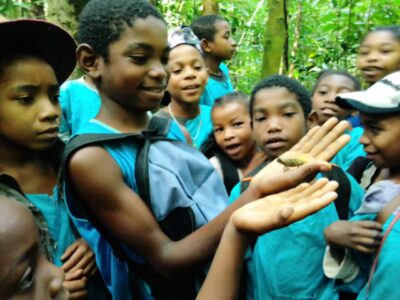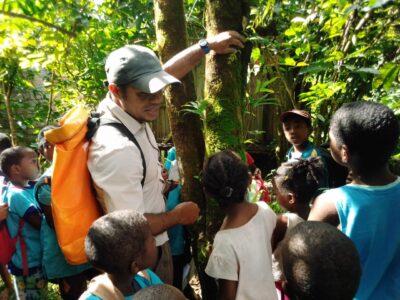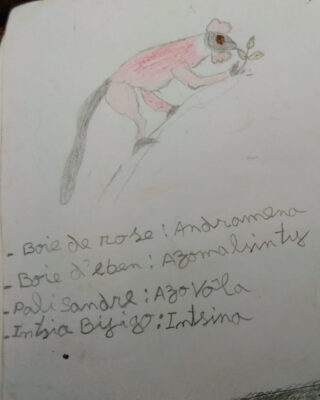 What We Do
What We Do

Madagascar. Photo by Pascal Elison
Our organisation Photography Inspiring Children in Conservation (PICC) is based on the concept of engaging with the natural world through visual arts.
Our goal is to inspire Malagasy students to become lemur conservation leaders within their communities by providing them with knowledge of lemur ecology, as well as local conservation issues and solutions. Malagasy students gain skills in photography, illustration, and storytelling, providing an effective foundation upon which they may seek conservation-oriented careers.
PICC was designed with a goal of building local capacity for sustainable conservation through educating and empowering both students and the broader community, including local teachers and elders.
The act of creating an image with photography or sketching rewires us to be truly present and see details and beauty on a deeper level of appreciation.
~Kathy West, PICC Director
How We Protect Lemurs And Other Wildlife
Over a two-week period, Malagasy students use customized coloring and activity books, worksheets, field journals, and DSLR cameras to document their local forests and develop scientifically accurate stories and illustrations.
They are encouraged to develop unique lemur conservation ideas, making contributions to their communities using their new skills. A village-wide gathering at the completion of the project celebrates the students’ works and recognizes participants as “Forest Ambassadors”. Equipment remains onsite, accessible to the students and teachers for sustained learning, career development, and conservation work.
About 3,000 tourists visit Masoala National Park (NP) per year. One of our goals is to give Malagasy students the opportunity to develop the skills needed to have future careers in ecotourism and conservation, improving their own lives while also protecting lemurs and their habitats.
It is important to foster the development of skills for conservation job opportunities. Research has shown that Malagasy people who are involved in ecotourism and earn their income from sharing wildlife experiences with visitors, will not hunt lemurs and will discourage others from doing so. At the same time, providing training and employability skills to Malagasy students improves livelihoods.
What Lemur Species We Protect
We began our program in June 2020 with the students in the village of Ambodiforaha in northeast Madagascar, adjacent to the stunningly beautiful Masoala National Park, an area rich in biodiversity. This National Park and UNESCO World Heritage site protects as much as 40% of Madagascar’s mammalian diversity. On the Masoala peninsula, 9 out of 10 species of lemurs present are vulnerable, endangered, or critically endangered, with the only remaining populations of some species found in this protected habitat.
PICC supports conservation of the following threatened lemur species in the Masoala NP and forest:
- Red ruffed lemur (Varecia rubra) (Critically Endangered)
- White-fronted brown lemur (Eulemur albifrons) (Endangered)
- Scott’s sportive lemur (Lepilemur scottorum) (Endangered)
- Moore’s woolly lemur (Avahi mooreorum) (Endangered)
- Aye-aye (Daubentonia madagascariensis) (Endangered)
- Hairy-eared dwarf lemur (Allocebus trichotis) (Vulnerable)
- Masoala fork-marked lemur (Phaner furcifer) (Vulnerable)
- Seal’s sportive lemur (Lepilemur seali) (Vulnerable)
- Northern bamboo lemur (Hapalemur occidentalis) (Vulnerable)
How We Support Local Communities
Recognizing that this national park belongs to local communities and the Malagasy people, we aim to help children understand how to identify and maintain healthy ecosystems, as well as to understand the cultural, environmental and economic benefits of protecting lemur habitat.

Ambodiforaha, Masoala, Madagascar
Empowering Teachers and Community Elders in Education
In addition to focusing on children, the PICC program includes participation of teachers and elder leaders with traditional ecological knowledge, making the likelihood of program success much higher. This empowers the older community members who have extensive knowledge of native plants and animals and are related to many of the children in the program. Unlike teachers, these elders are seen as local leaders with ancestral ties to the land. This project acknowledges the importance of the Malagasy people’s place in their landscape. We are interested in learning from them, and in returning knowledge to the community through the workshops, books and posters of student writing, illustrations, and photographs. Participating teachers are expanding their knowledge base in order to educate other students and teachers in nearby villages.


